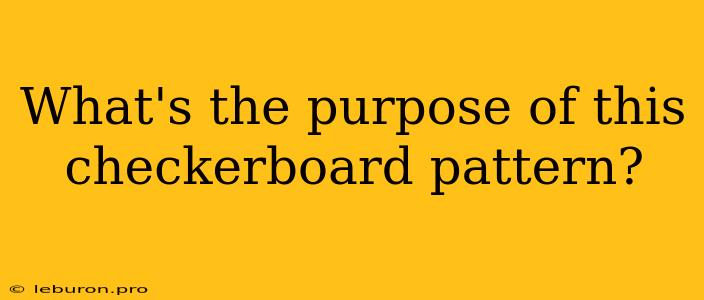The checkerboard pattern, with its alternating squares of contrasting colors, is a ubiquitous design element found in various contexts, from chessboards to kitchen floors. Its simple yet striking appearance often sparks curiosity about its deeper purpose. Beyond its aesthetic appeal, the checkerboard pattern holds a surprising range of functions and symbolism, reflecting its multifaceted nature across history and cultures. Delving into the purpose of this seemingly straightforward design reveals a fascinating tapestry of practical applications, cultural significance, and even scientific intrigue.
Practical Applications of the Checkerboard Pattern
The checkerboard pattern's most straightforward application lies in its ability to enhance visual clarity and organization. This is particularly evident in its use in checkerboards, where the contrasting squares facilitate easy tracking of pieces during gameplay. The same principle applies to chessboards, which employ the checkerboard pattern to create a visually distinct playing surface, aiding in strategic planning and piece movement.
Beyond the Gameboard: Applications in Everyday Life
The checkerboard pattern extends its practical utility beyond the realm of games. Checkered floors, prevalent in kitchens and other spaces, offer a similar visual clarity advantage. The contrasting squares help define areas, creating a sense of structure and organization. This functionality is further enhanced when checkerboards are used to guide foot traffic in public spaces or designate different zones in factories and warehouses.
Checkerboard patterns can also enhance visibility and safety. Checkered flags, often seen at racetracks and construction sites, provide clear visual warnings, ensuring safety for workers and onlookers. Similarly, checkerboard markings on roads serve as visual guides for drivers, aiding in lane identification and reducing the risk of accidents.
Cultural Significance and Symbolism
Beyond its practical applications, the checkerboard pattern holds a wealth of cultural significance and symbolic meaning. Its presence in various cultures reflects a deeper understanding of its symbolic power.
The Checkerboard in History and Art
Checkerboard patterns appear in ancient mosaics, symbolizing order and balance in the cosmos. Checkered textiles have been used in traditional clothing and tapestries across different cultures, representing wealth, status, and craftsmanship.
Checkerboard patterns often serve as decorative motifs in architectural elements. The use of checkered tiles in checkerboard floors in churches and palaces reflected the power and grandeur of the institutions they adorned. Checkerboards also feature in traditional artwork, contributing to themes of duality, harmony, and the interplay of opposites.
The Checkerboard and Modern Interpretation
In modern times, the checkerboard pattern has found its way into contemporary art, design, and fashion. It continues to be a powerful symbol of duality, representing the constant interplay of light and dark, male and female, yin and yang. Its versatility allows for various interpretations, from playful and whimsical to sophisticated and abstract.
Scientific Exploration of the Checkerboard Pattern
The checkerboard pattern's influence extends even into the realm of scientific exploration. Checkerboards, with their simple yet captivating design, have sparked research into the underlying principles of human perception and visual processing.
The Checkerboard Illusion and Visual Perception
The checkerboard illusion, also known as the Hermann grid, is a classic example of how our brains perceive visual patterns. This illusion demonstrates that our perception is not always accurate, and that the brain fills in missing information based on surrounding patterns.
Checkerboards are also used in research into color perception and contrast sensitivity. By studying the checkerboard pattern, researchers can gain insights into how the human visual system processes information and interprets different colors and patterns.
Conclusion
The checkerboard pattern, with its simple yet versatile design, holds a remarkable range of functions and symbolism. From its practical applications in games, architecture, and safety to its cultural significance and scientific exploration, the checkerboard pattern continues to intrigue and fascinate. Its enduring appeal lies in its ability to transcend cultural boundaries and spark our curiosity about the world around us. Whether it is used to enhance visual clarity, convey symbolic meaning, or delve into the mysteries of human perception, the checkerboard pattern remains a timeless testament to the power of simple design.
